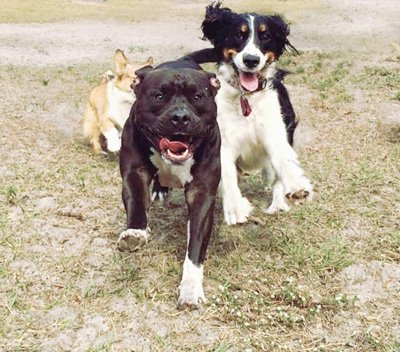6 Super Safety Tips for the Dog Park
Learn more, visit out pet health library:

Make sure everyone has a good time and stays happy and healthy on your next visit.
- Visit your veterinarian. Your dog should be current on vaccinations, and fl ea and intestinal parasite preventives before running around with other dogs at the dog park. Before a dog park visit is also a great time to talk about your dog’s temperament and whether he’s ready to engage with other pets and people in an off -leash environment. If your pet is intact, discuss neutering since intact dogs are more likely to fi ght. Signs of estrus aren’t always obvious so it is never a good idea to take an intact female to a dog park.
- Know commands. You need to be able to control your dog if a problematic situation arises. Make sure your dog knows some basic obedience commands—“come,” “sit,” “stay” and “leave it”—in order to get him out of trouble.
- Find the right spot. You want to find the dog park that’s just right for you and your dog. Ideally, it should have:> adequate room for dogs to run
> secure fences
> a double gate for entry
> a separate area for small dogs
> a safe, sheltered area
> a source of drinking water
> no stagnant water
> posted rules of conduct.If you visit a park and it’s too congested or you see overly assertive or aggressive dogs, or owners who aren’t watching their dogs, keep looking. - Be prepared. Take these essentials with you:> bags for cleaning up messes
> drinking water, in case the park doesn’t have a source
> a leash
> a cell phone, in case you need assistance. It’s also a good idea to take something to break up an aggressive situation between dogs, such as a veterinarian-recommended animal deterrent spray or a compressed-air horn. - Be watchful. When you first arrive, wait until no other dogs are at the gate. Once it’s clear, you can take your dog off the leash and let him run through the gate. Watch your dog, but also keep an eye out for overly excited or aggressive dogs near him. Some dogs can be very aggressive around toys or treats, so don’t give these to your pet if other dogs are around. If your dog starts acting fearful or overwhelmed, use a basic command in an upbeat voice to call him back. Also, don’t hesitate to call animal control if a dog is aggressive and the owner isn’t being attentive.
- Know when to intervene. Playful dogs bounce around, wag their tails and have relaxed postures and facial expressions. Be watchful for signs of aggression— growling, a stiff posture, raised hackles and tail, a closed mouth or a stronger focus. Don’t yell if your dog and another dog start growling at each other, because that could trigger a fi ght. Instead, use a basic command in an upbeat tone to call your dog back to you and move to another spot. If a fight does break out, don’t grab your dog’s collar—you could get hurt. Instead, use your deterrent spray, an airhorn, a water hose or toss coats over the dogs to break up a fight.
Courtesy of DVM360 Source: Wayne Hunthausen, DVM
- Behavior (12)
- Caring for your pet (266)
- cat (6)
- Community Events (19)
- dog (7)
- From Our Clients (15)
- Happy Tails (9)
- News (424)
- Press (53)
- Products (2)
- Questions (4)
- Recalls (1)
- Special Offers (5)
- Tips & Advice (231)
- Uncategorized (19)
- Veterinary Services (48)
